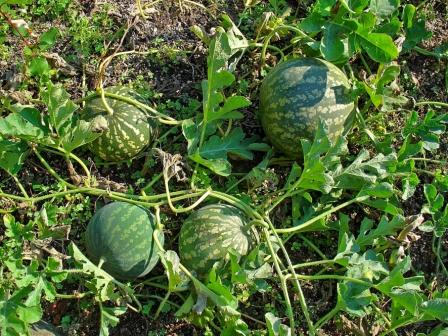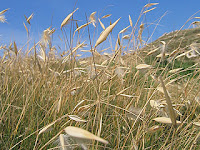White Goosefoot

White goosefoot (Chenopodium album L.) grows in the high altitude areas in Morocco and throughout Africa. An annual flowering plant that grows more than 1 meter tall, the young plants and its leaves are boiled and eaten as vegetables. Its seeds are dried and ground into flour for bread-making or boiled to make hot cereal. Other names include lamb's quarters and pigweed.
The egusi melon (Citrullus lanatus)

The egusi melon (Citrullus lanatus) belongs to the Cucurbitaceae family--the same family of all the melons, squashes and gourds. Egusi melon grows in Morocco and throughout west, central, east and South Africa. The fruit ranges from bitter to sweet in taste and the seeds are roasted and eaten as a snack, brewed as a coffee substitute, ground into a thickening powder or pressed for its oil. Egusi melon is also called West African watermelon, egusi watermelon and desert watermelon.
Crambe

An annual herb that grows more than 1 meter in height and produces many fine branches, Crambe (Crambe hispanica) naturally grows in Morocco, throughout the Mediterranean and the Middle East. Its main cultivation is for the harvesting of its seed oil used in industrial lubricants and products, as stated by Plant Resources of Tropical Africa (PROTA). The leaves are consumable, and its seeds have topical medicinal properties. Its other common names include colewort, Abyssinian mustard and Abyssinian kale.
Esparto Grass
Esparto grass (Macrochloa tenacissima) grows in Morocco and the Mediterranean area and its fibers are harvested to make paper, ropes and baskets. One of Morocco's famous cultural expressions is seen through their art of basket weaving. As stated by the USDA Germplasm Resources Information Network, some of its common names include halfa, alfa and flechilha.
Bay Laurel
This is the tree that yields the flavorful bay leaves used in culinary dishes. Native to Morocco and the Mediterranean, the aromatic evergreen Bay Laurel (Laurus nobilis) grows to a towering 40 feet tall. Its leaves in dried or fresh form are used as spice, tea, for natural medicinal remedies, and its essential oil is used in soap-making and as an insect repellent. Bay Laurel is also called laurel, sweet bay and bay.

morocco culture,moroccan food,morocco food,moroccan cuisine,morocco beaches,moroccan meal,beaches in morocco,moroccan culture,hercules cave,hercules cave morocco

